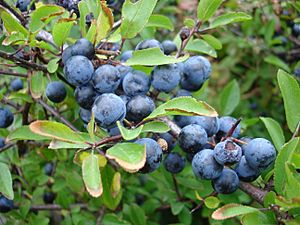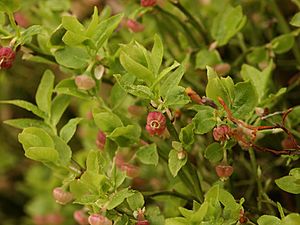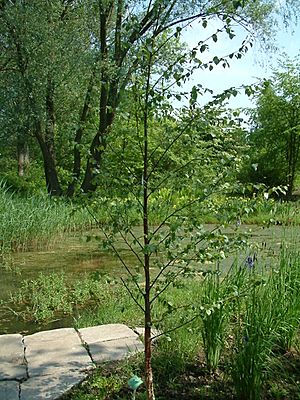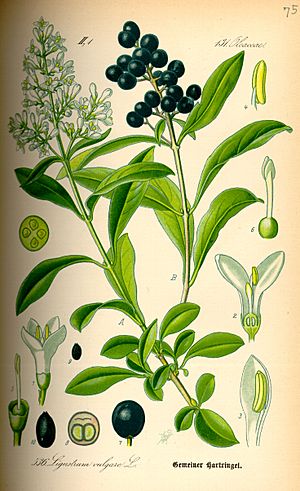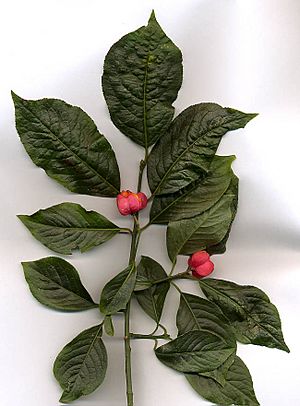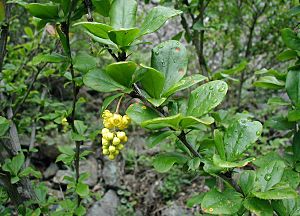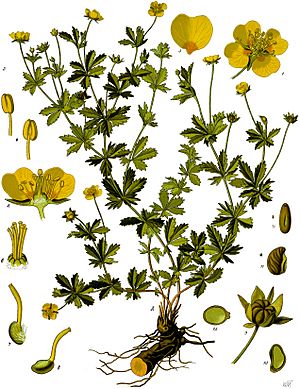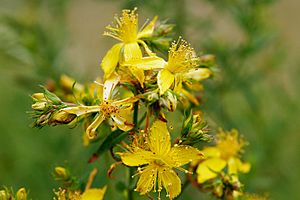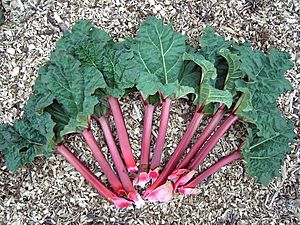Traditional dyes of the Scottish Highlands facts for kids
Traditional dyes of the Scottish Highlands are natural colors made from plants and other things found in nature. People in the Scottish Highlands, also known as Scottish Gaeldom, used these dyes to color their clothes and fabrics long ago.
These natural dyes created many bright colors. Today, we mostly use modern chemical dyes because they are easier to use. But it's fun to learn how people made beautiful colors from nature!
Contents
Making Colors from Nature
Many dyes came from lichens. Lichens are like mosses that grow on rocks and trees. People called the useful ones "crottle."
To dye fabric, they first washed the thread very well. Then, they put it into a pot of boiling dye. A special liquid, often animal-based, was used to help the colors stick to the fabric. This liquid is called a "mordant." They would lift the thread out with a stick, then put it back in until it was fully colored. If the thread was dyed blue, they washed it in salt water. For other colors, they used fresh water.
Amazing Colors from Plants
Here are some of the main colors people made and what they used to create them:
Rich Claret Red
- Claret is a deep red color. People made it from a lichen called Lecanora tartarea. They scraped this lichen off rocks. Then, they soaked it in a special liquid (like aged urine) for three months! After that, they made the lichen into cakes and dried them. When ready to dye, they ground the cakes into powder. They used a substance called alum to make the color stay bright.
Deep Black Colors
- Finest Black: This came from common dock root mixed with a mineral called copperas.
- Other Blacks: They also used oak bark, iris root, hawthorn bark, or alder bark, all with copperas.
- Blue-Black: This color came from sloe berries (Prunus spinosa) or red bearberry.
Bright Blue Shades
- Blue: People used blaeberry (Vaccinium myrtillus) with alum or copperas. They also used elderberry (Sambucus nigra) with alum, or a plant called elecampane.
Earthy Brown Tones
- Brown: This color came from a yellow wall lichen (Xanthoria parietina) or a dark lichen.
- Seaweed Brown: A type of seaweed called dulse also made brown.
- Dark Chestnut-Brown: The roots of the white waterlily made this color.
- Reddish Brown: A dark purple lichen was used for this shade.
- Fawn (Light Brown): The bark of the birch tree (Betula pubescens) created a light brown color, like that of a young deer.
Lively Green Hues
- Green: Ripe privet berries with salt could make green. They also used wild mignonette with indigo (a blue dye), or the bark of whin (gorse).
- Dark Green: People used heather (Erica cinerea) with alum. The heather had to be picked from a shady spot before its flowers opened. Iris leaves also made dark green.
Pretty Purple and Magenta
- Magenta: The common dandelion (Taraxacum officinale) could make this bright pinkish-purple color.
- Purple: The Spindle tree (Euonymus) with a chemical called sal-ammoniac made purple. Sundew (Drosera rotundifolia) and blaeberry (Vaccinium myrtillus) with alum also created purple.
Bright Orange Shades
- Orange: This color came from ragweed (Senecio jacobaea) or barberry root (Berberis vulgaris).
- Dark Orange: The bramble plant (Rubus fruticosus) made a darker orange.
Bold Red Colors
- Red: Plants like Tormentil (Potentilla tormentilla) and certain rock lichens made red.
- Fine Red: A very nice red came from the roots of a plant called ladies' bedstraw. They boiled the roots and yarn together, adding alum to make the color last.
- Crimson: A lichen called "crotal-corcar" (Lecanora tartarea) was used to make a bright crimson red.
- Scarlet: A limestone lichen was used for scarlet, especially in places like Shetland. Ripe privet berries with salt could also make scarlet.
Soft Violet Hues
- Violet: Wild cress (Nasturtium officinalis), vetchling (Lathyrus linifolius), and bilberries with alum all made violet colors.
Sunny Yellow Colors
- Yellow: Many plants could make yellow, including apple trees, ash trees, buckthorn, poplar, elm, bog myrtle, and bracken roots.
- Bright Yellow: Sundew (Drosera rotundifolia) with ammonia made a bright yellow.
- Rich Yellow: St John's Wort with alum created a rich yellow.
- Dirty Yellow: Even peat soot could be part of a yellow dye recipe, though it wouldn't make yellow on its own. Rhubarb (Rumex alpinus) also made yellow.


